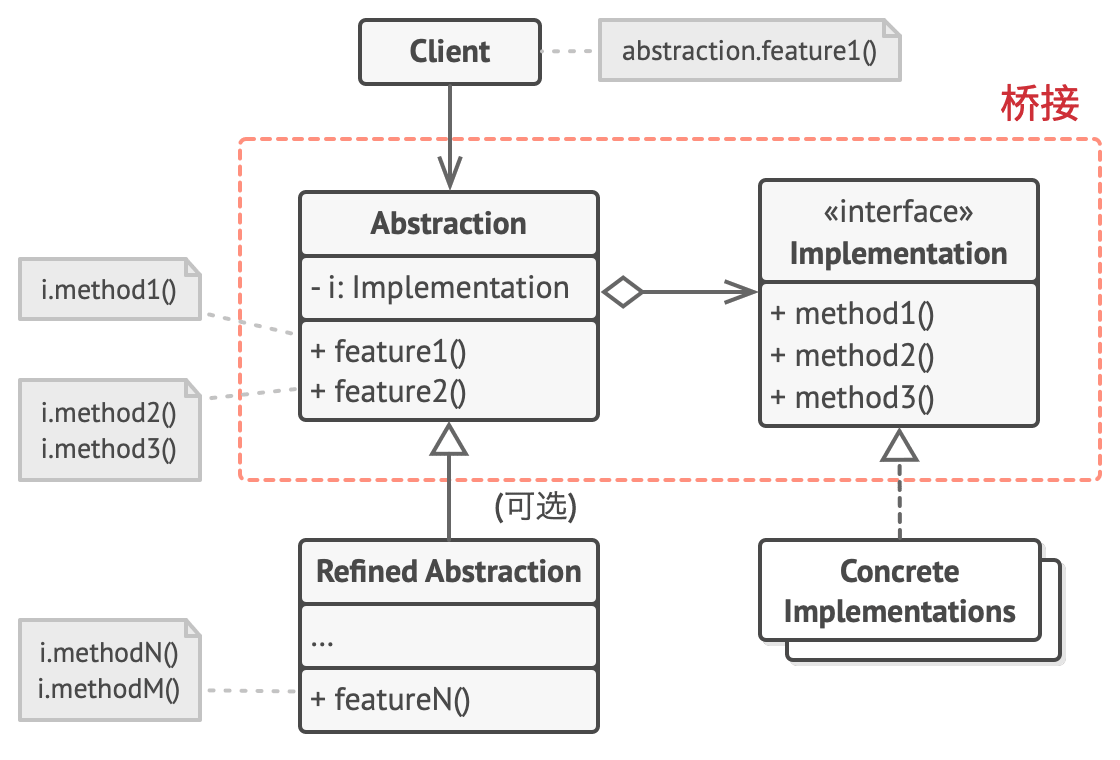桥接模式
桥的作用就是将两个独立结构连接起来。
设计模式中的桥接是将两个独立的层次结构连接起来。
桥接模式是将抽象部分与它的实现部分分离,使它们都可以独立地变化。
这里的抽象与编程语言中的抽象无关,而是指一些实体的高阶控制层。该层自身不完成任何具体的工作, 它需要将工作委派给实现部分层(也被称为平台)。
桥接模式的结构如下:

抽象部分 (Abstraction) 提供高层控制逻辑, 依赖于完成底层实际工作的实现对象。所以抽象部分保存了一个对实现部分(Implementation)的引用,这个引用就是连接抽象部分和实现部分的桥。
比如遥控器,只需要实现控制逻辑,实际的功能都是由所控制的终端提供:
class RemoteControl {
protected device: Device;
// 遥控器基类声明了一个指向设备对象的引用成员变量。
// 所有遥控器通过通用设备接口与设备进行交互,使得同一个遥控器可以支持不同类型的设备。
constructor(device: Device) {
this.device = device;
}
togglePower(): void {
this.device.isEnabled() ? this.device.disable() : this.device.enable();
}
volumeDown(): void {
this.device.setVolume(this.device.getVolume() - 10);
}
volumeUp(): void {
this.device.setVolume(this.device.getVolume() + 10);
}
channelDown(): void {
this.device.setChannel(this.device.getChannel() - 1);
}
channelUp(): void {
this.device.setChannel(this.device.getChannel() + 1);
}
}
实现部分 (Implementation) 为所有具体实现声明通用接口。 抽象部分仅能通过在这里声明的方法与实现对象交互。
所以作为终端设备,应该为抽象部分提供所需的接口:
interface Device {
isEnabled: () => boolean;
disable: () => void;
enable: () => void;
setVolume: (percent: number) => void;
getVolume: () => number;
setChannel: (channel: number) => void;
getChannel: () => number;
}
抽象部分通常声明一些复杂行为, 这些行为依赖于多种由实现部分声明的原语操作。比如控制设备的开启和关闭,实际上是由实现部分的三个功能组成。
具体实现 (Concrete Implementations) 中包括特定于平台的代码。它们必须遵循相同的接口。
class Tv implements Device {
// ...
}
class Radio implements Device {
// ...
}
有了遥控器和具体的设备,那么就可以对他们实施具体的连接了:
const tv = new Tv()
const remote = new RemoteControl(tv)
remote.togglePower()
如果我们基于设备接口声明的方法,想扩展一个拥有静音功能的遥控器,我们并不需要去修改设备内部的实现,而只需要单独扩展遥控器类即可:
class AdvancedRemoteControl extends RemoteControl {
mute() {
this.device.setVolume(0);
}
}
这种功能增强的遥控器被称为精确抽象(Refined Abstraction),提供控制逻辑的变体。与其父类一样, 它们通过通用实现接口与不同的实现进行交互。
练习
假如你有一个几何形状 Shape 类, 从它能扩展出两个子类:圆形 Circle 和方形 Square。你希望对这样的类层次结构进行扩展以使其包含颜色, 所以你打算创建名为红色 Red 和蓝色 Blue 的形状子类。但是,由于你已有两个子类,所以总共需要创建四个类才能覆盖所有组合,例如蓝色圆形 BlueCircle 和红色方形 RedSquare。在层次结构中新增形状和颜色将导致代码复杂程度指数增长。
我们试图在两个独立的维度——形状与颜色——上扩展形状类,就可以使用桥接模式来解决这个问题。
我们可以在形状类中添加一个指向某一颜色对象的引用。形状类可以将所有与颜色相关的工作委派给连入的颜色对象。这样的引用就成为了形状和颜色之间的桥梁。此后,新增颜色将不再需要修改形状类。
/** 实现部分接口 */
interface Color {
drawAPI: (width: number, height: number, radius?: number) => void
}
/** 抽象部分基类 */
class Shape {
protected color: Color
// 添加指向颜色对象的引用
constructor(color: Color) {
this.color = color
}
draw() {}
}
/** 遵循实现部分接口来具体实现颜色子类 */
class Red implements Color {
drawAPI(width: number, height: number, radius?: number) {
console.log(`color: red, width: ${width}, height: ${height}, radius: ${radius}`)
}
}
class Circle extends Shape {
private width: number
private height: number
private radius: number
constructor(width: number, height: number, radius: number, color: Color) {
super(color)
this.width = width
this.height = height
this.radius = radius
}
draw() {
this.color.drawAPI(this.width, this.height, this.radius)
}
}
class Square extends Shape {
private width: number
private height: number
constructor(width: number, height: number, color: Color) {
super(color)
this.width = width
this.height = height
}
draw() {
this.color.drawAPI(this.width, this.height, 0)
}
}
const redCircel = new Circle(10, 10, 10, new Red())
redCircel.draw()
const redSquare = new Square(5, 5, new Red())
redSquare.draw()
class Blue implements Color {
drawAPI(width: number, height: number, radius?: number) {
console.log(`color: blue, width: ${width}, height: ${height}, radius: ${radius}`)
}
}
const blueCircle = new Circle(5, 5, 5, new Blue())
blueCircle.draw()
const blueSquare = new Square(5, 5, new Blue())
blueSquare.draw()